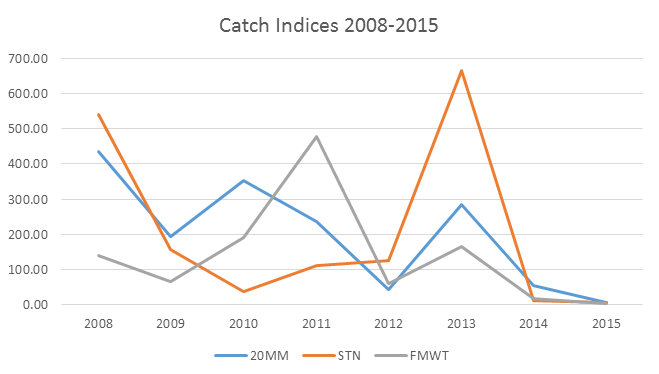In a recent post I suggested possible prescriptions for Water Year 2016 that would help toward recovery of the nearly extinct Delta smelt. In another recent post I also described the probable extinction of longfin smelt. Both smelt species have suffered considerably in the seven years of drought in the last ten years due to lack of freshwater outflow from the Delta and excessive Delta exports.
In 2016 longfin smelt should benefit from the same prescriptions for higher outflow and lower exports in similar ways as Delta smelt. In the past eight years, 2008-2015, Delta outflow is certainly an important factor in longfin survival and production. In Figure 1 the relationship between the Fall Midwater Trawl Index for longfin smelt and June Delta outflow for the years 2008-2015 shows a strong positive trend. 2010 and 2011 were the wettest two years in the series and had the highest indices and the driest two years; 2014 and 2015, having the lowest. With 2016 being a “normal” water year similar to 2010, a prescription of 15,000 cfs June outflow would be expected to bring an index closer to 200. But since Delta standards require at most 7100 cfs outflow, Mother Nature or some other action (e.g., reservoir releases) will be necessary to get June outflow up to the 2010 level.
In reality, what controls longfin production is more than just June outflow. As described in my previous post, longfin smelt are also suffering from a lack of spawners this year, so there may not be sufficient young-of-the-year abundance this year (see Figure 2) to reach the index level produced in 2010. Relatively high spring juvenile abundance in 2008 and 2013 failed to produce good fall abundance. With or without good June outflow, it is unlikely that there will be a good fall index in 2016 because of the depressed population level. However, that should not preclude a good effort. Spring abundance was also not extraordinary in 2010 and 2011, but these years still produced improvements in fall longfin abundance.

Figure 2. Catch indices trends for longfin smelt from 2008-2015 in three major Bay-Delta surveys: March 20-mm Survey, June Summer Townet Survey, and Fall Midwater Trawl Survey. (Note: The 20-mm index for March 2016 was 6.)
In its Finding relative to the proposed listing of longfin Smelt, the US Fish and Wildlife Service stated: “Freshwater flow is strongly related to the natural hydrologic cycles of drought and flood. In the Bay-Delta estuary, increased Delta outflow during the winter and spring is the largest factor positively affecting longfin smelt abundance (Stevens and Miller 1983, pp. 431–432; Jassby et al. 1995; Sommer et al. 2007, p. 274; Thomson et al. 2010, pp. 1439–1440). During high outflow periods, larvae presumably benefit from increased transport and dispersal downstream, increased food production, reduced predation through increased turbidity, and reduced loss to entrainment due to a westward shift in the boundary of spawning habitat and strong downstream transport of larvae (CFDG 1992; Hieb and Baxter 1993; CDFG 2009a). Conversely, during low outflow periods, negative effects of reduced transport and dispersal, reduced turbidity, and potentially increased loss of larvae to predation and increased loss at the export facilities result in lower young-of-the-year recruitment. Despite numerous studies of longfin smelt abundance and flow in the Bay-Delta, the underlying causal mechanisms are still not fully understood (Baxter et al. 2010, p. 69; Rosenfield 2010, p. 9).1
Given the depressed state of this species that is listed as threatened under the California Endangered Species Act, it is reasonable to attempt an ambitious prescription this June that has the potential to bring some measure of recovery.

